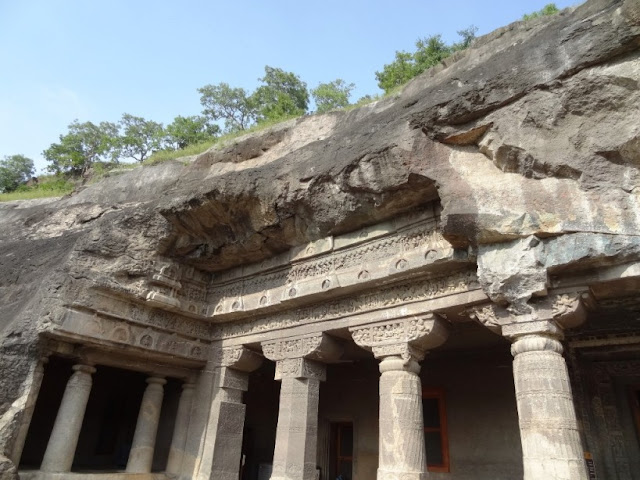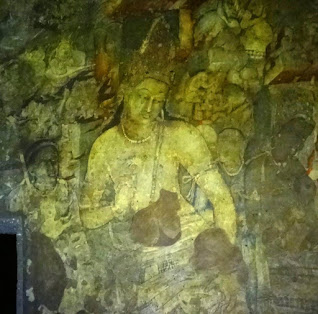This is a detailed guide for Ajanta caves, the world heritage site located in Maharashtra, India. Ajanta caves are ancient Buddhist temples and are famous for mural paintings.
Where is Ajanta Caves located?
Ajanta caves are located in a remote part of Maharashtra. The nearest airport is in Aurangabad, approximately 104 kilometers from Ajanta. The nearest railway station is Jalagaon junction which is just six kilometers from Ajanta. Tourist often get taxis or buses from Aurangabad to reach Ajanta caves.
Who built the Buddhist cave temples in Ajanta?
The construction period of Ajanta caves vary greatly. In fact, it was built in two phases which are around 600 years apart! The first phase began in 2nd Century BC during the times of Satavahana dynasty. Caves 9,10,12,13 and 15A were constructed during this period. The rest of the Ajanta caves are from a later time period of AD 463, during the Vakataka dynasty under the patronage of King Harisena. |
| Ajanta caves from a distant view point |
The information that I present in this guide is based on the research by legendary Ajanta historian Walter M Spink.
Guide for Ajanta Cave Number 1
The Vakataka Emperor Harisena built the cave 1 in Ajanta. Construction of this cave temple was started around AD 468. Surprisingly, the Emperor's cave was started only five years after the the second phase active construction started at Ajanta. Harisena was a not a Buddhist but a Saivaite( A follower of Hindu religion whose chief affiliation is Shiva).
 |
| Cave number 1 - façade |
It has colonnaded veranda and one can see that the top of the columns are carved extensively. As one enters inside the veranda, the left and right side walls has a painting of Prince Siddhartha's encounter with an old man, a sick man and a dead man. The cave paintings of Ajanta depicts Jataka tales, stories from many lives of Buddha. The painting on the right wall of the Veranda depicts his renunciation of worldly attachments and leaving the palace. Hence he starts his journey towards enlightenment and becoming Buddha.
 |
| Ajanta cave number one shrine Photo : By Christian Luczanits - Christian Luczanits, CC BY-SA 3.0, Link |
The biggest attractions in Ajanta cave number 1 are the murals of Vajrapani, and Padmapani – the compassionate Bodhisattvas. It is not possible to go very close to the sanctum or touch the idol of Buddha. However, one can see that the Buddha is in a seated position, with attendant bodhisattvas on either sides. Also there is a pair of flying dwarfs endowing Buddha with garlands. On outside the sanctum, precisely on either side walls are the world famous paintings of Bodhisattvas Vajrapani, and Padmapani.
Painting of Padmapani - Left side of Shrine Antechamber
Ajanta cave 1 contains the iconic painting of Padmapani. Scholars believe that this is a depiction of the bodhisattva Avalokitesvara. This muralof Avalokitesvara conveys the poise and compassion. In Buddhism, Avalokitesvara is considered as an ascetic often depicted with dreadlocks, a pilgrim’s flask and a lotus. However, this figure has a royal appearance probably due to the influence of the Royal patron, emperor Harisena. Towards the Bodhisattvas right hand we can see a crowned attendant who is bringing an offering of fresh flowers to the bodhisattva.
 |
| Padmapani - Ajanta cave - 1 |
Painting of Vajrapani - Right side of Shrine Antechamber - Ajanta cave 1
As if paired with Padmapani, on the right side of Ajanta cave Shrine antechamber, we can find the mural of Vajrapani. He is a protector and guide Bodhisattva often depicted in royal attire. His crown is highly ornate and so are the cloths. Vajrapani means one who holds the thunderbolt, clearly a sign of power. According to Ajanta conventions, Vajrapani is shown paired with bodhisattva Avalokitesvara.
Cave paintings of Ajanta Cave - 1
Ajanta is rich with ancient paintings, most of them are depiction of Jataka Tales( stories about the previous lives of Buddha). Cave 1 being of royal patronage, it is not surprising to see a huge collection of detailed murals depicting. However, much of these paintings are in rather damaged state and only with a help of a good guide one can decrypt the stories.
Maitribala : The benevolent selfless king
The Kingdom of Maitribala was so peaceful. Once three demons visited the kingdom and they saw a cowherd grazing unsupervised.(on the right side of the below painting you can see some cows, especially a white one). They informed the demons that in the Kingdom of Maitribala, no one has to fear anything. The demons wanted to try the king. They took the form of Brahmins and asked the king for a feast. King offered a vegetarian meal. The demons took the original form and informed the king that they take only flesh and blood. The king, who did not want to harm another being offered to cut a piece of himself and give to the demons. The demons realized the greatness of King. You can read a long story of Maitribala Here.
 |
Mural of Maitribala
|
This is a close up of the above painting, you can see King Maitribala sitting cross legged on the right side and the demon in form of a Brahmin sits on the left( head missing). The consort of Maitribala and many courtiers also portrayed.
Janaka Jataka: The king who decided to renounce the world
This Ajanta cave painting tells the story of King Mahajanaka who decided to renounce his kingdom and become an ascetic. His Queen Sivali attempts to stop Mahajanaka. She wears her best dress and make up in order to lure the king. She also arranges a dance so that the king would stay in palace. Mahajanaka Jataka is described in detail here.
 |
| Janaka Jataka By Meister des Mahâjanaka Jâtaka [Public domain], via Wikimedia Commons |
The famous painting of the dancing girl of Ajanta is also a part of this Jataka story. It depicts a beautifully dressed dancer adorned in fabric reminding Pochampalli weaving style of India.
 |
| Ajanta cave painting 2- Janaka Jataka - The dancing girl of Ajanta |
Shibi Kapota Jataka: The kind King Shibi and the pigeon
The story of Shibi and the pigeon is a very famous Jataka tale. Shibi was a very kind king. Once a pigeon who was chased by a falcon landed on the lap of Shibi. The pigeon begged for protection and the falcon argued that Shibi has no right to take away it's prey. Shibi, being justful and at the same time kindhearted decided to please both falcon and pigeon. He cut off a pigeon's weight worth flesh from his own body and offered it to the falcon.
 |
| Shibi Kapota Jataka |
Apart from these main paintings, there are many more Jataka tales are depicted on the walls. Some of them are really damaged which can only be explained by an experienced guide - Mahasudarshana Jataka, Udrayana Jataka, Sudhana Jataka, Shankhapala, Kalyankarin,Sumagadha, Mahoshadha, Mahapratiharya, Prabhasa are some of the Jataka tales depicted in the Ajanta cave paintings.
Ceiling decorations
Another attraction is the ceiling paintings of Ajanta caves. Unlike the walls, the main theme of these paintings are animals, playful dwarfs and ingenious floral and geometrical designs. There are also circular paintings with a hook in the center. These are intricately painted with bright colors which reminds us of a magic carpet.
 |
| Painted ceiling of Ajanta |


casino bonus codes, free slots casino bonus codes
ReplyDeleteThere is no limit to the number of spins offered on a given 상주 출장샵 game; 춘천 출장마사지 no limit on how many times 청주 출장안마 you 동해 출장안마 deposit a bonus. There is also 광주 출장마사지 a limit on what
Thank you for writinng this
ReplyDeletePost a Comment